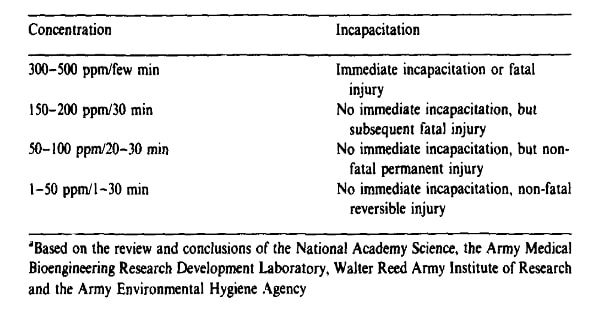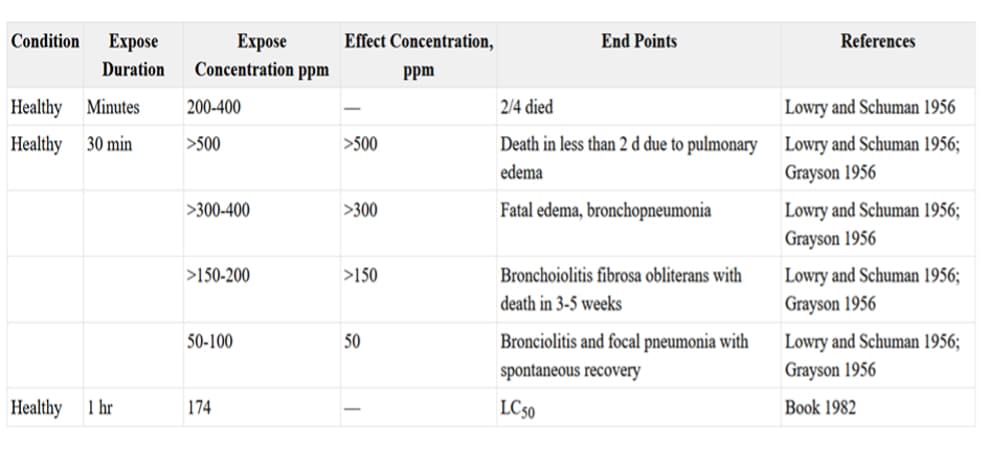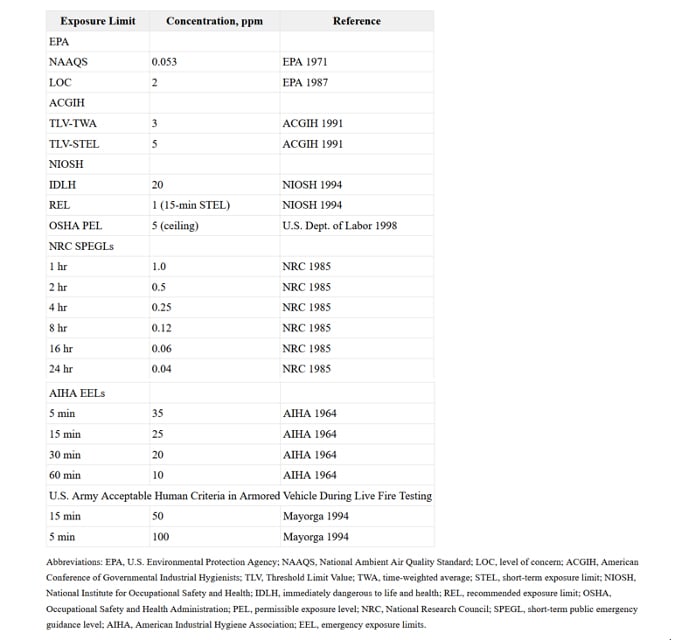- Nitrogen Dioxide poisoning is an occupational hazard in the aerospace and defense industries.
- Ground operations and cruising in airports cause chronic nitrogen dioxide exposure resulting in premature death.
- Exposure during normal operations is low in space explorations, but accidents can release hazardous amounts of nitrogen dioxide.
- In the defense industry, normal combat operations and accidents can expose soldiers to hazardous levels of nitrogen dioxide.
Nitrogen dioxide poisoning is an occupational hazard in the aerospace and defense industries. The gas is breathed in, leading to severe respiratory problems and death. Due to the serious effects, Nitrogen dioxide has, it is essential to know where and how it is produced so that these areas can be monitored and the personnel are better protected.
Nitrogen Dioxide Poisoning as Occupational Hazard
Nitrogen dioxide (NO2) is one of the gases produced due to fuel combustion and is a major pollutant and an occupational hazard. It is a clear and odorless gas in low concentrations, but NO2 gas is reddish-brown at higher concentrations and has a harsh odor.
Generally, people are exposed to chronic or intermittent low NO2 levels. However, in specific occupations, the gas presents a localized problem because personnel are exposed to acute high-dose events or accidents, which can be harmful or even fatal for people. Occupations where NO2 is a problem, include firefighters, personnel working in traffic, welding, military, combat, aerospace, and welding sectors.
Nitrogen Dioxide Risks in the Aerospace Aircraft
Ground operations, takeoff, and landing at airports produce NO2 and particulate matter emissions. The health effects of NO2 exposure exceed that of particulate matter, and the aircraft cruise emissions have been causing premature mortality not only for aviation ground personnel and the local population around airports.
Around 90 percent of aircraft NO2 emissions occur 3000 feet above the ground at a higher atmosphere, contributing to ozone formation at ground level.
Space exploration also carries NO2 risks as the gas is an oxidizing agent in rocket fuels. Usually, rocket launches have little NO2 production, but large amounts of NO2 are produced during catastrophic aborts, posing a danger to people at launch sites. Accidental exposures to NO2 in space explorations can be as high as 250 parts per million (ppm).
Nitrogen Dioxide Risks In the Defense Industry
In the defense industry, NO2 exposure risks occur in ships, submarines, aircraft, and armored vehicles. Munitions attacks, detonations of explosives, and missiles hit can also expose defense personnel to high levels of NO2. The gas is a nitrating agent in explosives. Moreover, Scud missiles, on breaking up, impact, or attack by munitions, release nitric acid and NO2, exposing troops to their effects.
Most research on civilian health investigates the impact of low-level NO2 on people; however, in the defense sector, personnel are exposed to acute and high levels of NO2. During military operations, exposure can be up to 500 ppm. Soldiers are also at greater risk of exposure than civilians, necessitating separate research. Army research looks into not only injury but physical and mental incapacitation caused by NO2 that can hamper military tasks and influence battle outcomes. Moreover, finding the effects is crucial to identify the injury that soldiers suffer so that they can get proper treatment.
Nitrogen Dioxide Health Effects
Nitrogen dioxide poisoning is similar in severity to carbon monoxide and produces various clinical effects depending on exposure intensity and duration.
Nitrogen dioxide has low solubility in water, so it goes deeper into the respiratory tract to the lungs without irritating. Mucus membrane irritation due to soluble gases makes people respond faster, so the absence of quick irritation by NO2 causes people to inhale larger doses. Table 1 lists the expected impact of different exposures to NO2.

Table 1: “1985 National Research Council Commission of Life Sciences Summary of NO2 effects for humans,” Mayorga, 1994. (Credits: https://apps.dtic.mil/sti/tr/pdf/ADA284106.pdf)
The general acute effects of NO2 exposure are as follows:
- Low concentrations of NO2 immediately cause irritation and burning of the eyes and skin. Breathing the gas causes nose and throat irritation, shortness of breath, and coughing.
- Medium concentrations cause pulmonary edema (fluid buildup), severe shortness of breath and is considered a medical emergency.
- High concentrations reduce the ability of blood to carry oxygen, causing headache, fatigue, dizziness, and blue-colored lips and skin. Higher concentrations cause breathing trouble, collapse, and death.
General chronic and repeated exposure can take months or years to show any effects, which can be one of the following:
- Cancer and permanent lung damage.
- Mutations or genetic changes.
- Reproductive problems in women by reducing fertility and affecting developing fetuses.
In addition to the abovementioned health effects, the defense industry considers incapacitation occurrence at different exposure intensities and duration, which are listed in Table 2.

Table 2: “1985 US Army summary of NO2-induced human incapacitationa,” Mayorga, 1994. (Credits: https://apps.dtic.mil/sti/tr/pdf/ADA284106.pdf).
The effects of accidental exposures at very high levels of NO2 that one can expect in the aerospace and defense industries are listed in Table 3.

Table 3: “Summary of NO2 toxicity in humans: Mortality from Accidental exposures,” NRC. (Image credits: https://www.ncbi.nlm.nih.gov/books/NBK230446/)
Permissible Levels in Workplaces
The aerospace and defense industries affect their personnel and civilians nearby, and permissible levels for several situations are provided. People with pre-existing cardiopulmonary problems and children are more sensitive to NO2 exposure.
For ambient conditions, permissible levels definitions depend on the agencies.
The World Health Organization (WHO) recommends <20 parts per billion (ppb) for chronic exposure and <100 ppb for acute exposures of one hour.
In New Zealand, the ambient air quality for NO2 is 100µg/m3 as a 24-hour average.
In the USA, the following guidelines apply for NO2:
- The USA’s EPA permits <53 ppb for chronic exposure and <100 ppb for a one-hour exposure.
- According to Occupational Safety and Health Standards (OSHA), the airborne permissible level (PEL) is 5 ppm.
- According to NIOSH, the airborne exposure limit is 1 ppm.
- ACGIH recommends an airborne exposure limit of 3 ppm averaged for an 8-hour work shift and a short-term exposure limit (STEL) of 5 ppm.
- The US Army limits for live testing in armored vehicles are <50 ppm for 15 minutes and <100 ppm for 5 minutes.
See Table 4 for detailed permissible levels for further NO2 intensity and durations as given by the US National Research Council for civilians and military.

Table 4: “ABLE E-3 Currently Recommended Civilian and Military Human Exposure Limits for NO2,” NRC (Credits: https://www.ncbi.nlm.nih.gov/books/NBK230446/)
Methods of NO2 Detection
To prevent nitrogen dioxide poisoning, the aerospace and defense industries can use portable devices for NO2 detection in all potential areas of emissions from armored vehicles to the ambient atmosphere.
Interscan’s GasD 8000 Series Portable Gas Analyzers has four variations with different sensitivity that can measure NO2 from 0-2000 ppb to 0-200 ppm. The most suitable option can be chosen depending on the site to be tested.
A bump test before each use is recommended to ensure the instrument functions properly.
Testing regularly can control occupational exposure to NO2 to ensure that personnel are not exposed to more than 1ppm of gas by volume during a sampling time of 15 minutes.
Each employer must follow the following rules in the USA regarding NO2 monitoring:
- Monitor the atmosphere within 30 days of installing a new process.
- The employer must install appropriate engineering controls if the NO2 levels are above permissible. Monitoring the site once in 15 days, until two consecutive readings, shows that NO2 levels are within permissible limits.
- The employers should keep recordings of all NO2 readings on the site and the names of people working there. Information on the type of respirator or other protective equipment used should be mentioned.
- Employers must preserve records of levels of NO2 each employee was exposed to for 20 years after the employee’s termination.
Best Practices for Preventing NO2 Poisoning
The preventative and therapeutic practices are the same for civilian and defense personnel.
According to OSHA, people’s personal protection must comply with provisions of 29 CFR 1910.134 for respiratory protection in the USA for general industries.
According to OSHA Hazard Communication Standard, 1910.1200, employers have several responsibilities such as:
- Provide training and information about NO2 toxicity to their employees.
- Employers must provide eye wash fountains and shower facilities near the work area.
- According to OSHA 1910.132, employers must determine the appropriate protective equipment for hazards and train employees on the need and use.
Some steps personnel must follow during work to prevent nitrogen dioxide poisoning are listed:
- Use ventilation where possible; if not, use respirators.
- Wear protective clothing.
- If exposed to NO2, immediately wash thoroughly.
- Pass on information about exposure risks to others.
- On exposure to NO2, change into clean clothes immediately. Launder the exposed clothes with due care and by employees trained in NO2 risks.
- Shower immediately.
- Protective equipment is needed while going into confined spaces.
Please note, the above list of employer responsibilities and personnel precautions is not exhaustive.
Some military-specific recommendations are as follows:
- Soldiers in armored vehicles must wear breathing masks connected to ventilation units.
- As a precaution against pulmonary effects, soldiers going into combat should have aerosolized or dietary antioxidants such as lipoic acid, Vitamin C and E, glutathione, or a combination.
Other NO2 Effects
Besides affecting people, NO2 is also harmful to the environment and animals. It leads to acid rain and destroys forests and crops. Animals can die on exposure to NO2 gas. NO2 is also a greenhouse gas that causes climate change. However, the immediate and most significant danger is to personnel, who must be protected through adequate monitoring, proper equipment, and rescue possibilities.
Written By
Dr. Vijayalaxmi Kinhal
Science Writer, CID Bio-Science
Ph.D. Ecology and Environmental Science, B.Sc Agriculture
Sources
Amaducci A, Downs JW. Nitrogen Dioxide Toxicity. [Updated 2023 Mar 13]. In: StatPearls [Internet]. Treasure Island (FL): StatPearls Publishing; 2023 Jan-. Available from: https://www.ncbi.nlm.nih.gov/books/NBK554539/
Centers for Disease Control and Prevention. (2014, October 21). Nitrogen Oxides. Centers for Disease Control and Prevention. https://wwwn.cdc.gov/TSP/MMG/MMGDetails.aspx?mmgid=394&toxid=69
Environmental Protection Agency. (n.d.). EPA. https://www.epa.gov/no2-pollution/basic-information-about-no2
Jarvis DJ, Adamkiewicz G, Heroux ME, et al. Nitrogen dioxide. In: WHO Guidelines for Indoor Air Quality: Selected Pollutants. Geneva: World Health Organization; 2010. 5. Available from: https://www.ncbi.nlm.nih.gov/books/NBK138707/
Kamangar, N. (2023, June 30). Nitrogen dioxide toxicity. Practice Essentials, Background, Pathophysiology. https://emedicine.medscape.com/article/302133-overview?reg=1&icd=login_success_email_match_norm
Mayorga M. A. (1994). Overview of nitrogen dioxide effects on the lung with emphasis on military relevance. Toxicology, 89(3), 175–192. https://doi.org/10.1016/0300-483x(94)90097-3
Miake-Lye, R.C., and Didier Hauglustaine, D. (2022). Impacts of Aviation NOx
Emissions on Air Quality, Health, and Climate. Retrieved from https://www.icao.int/environmental-protection/Documents/EnvironmentalReports/2022/ENVReport2022_Art18.pdf
National Research Council (US) Subcommittee on Rocket-Emission Toxicants. Assessment of Exposure-Response Functions for Rocket-Emission Toxicants. Washington (DC): National Academies Press (US); 1998. Appendix E, ACUTE TOXICITY OF NITROGEN DIOXIDE. Available from: https://www.ncbi.nlm.nih.gov/books/NBK230446/
NAP.EDU. (2007). Emergency and continuous exposure guidance levels for selected submarine contaminants: Volume 1. 10 Nitrogen Dioxide | Emergency and Continuous Exposure Guidance Levels for Selected Submarine Contaminants: Volume 1 | The National Academies Press. (n.d.). https://nap.nationalacademies.org/read/11170/chapter/12
New Jersey Department of Health and Senior Services. 2000. Hazardous Substance Fact Sheet. Retrieved from https://nj.gov/health/eoh/rtkweb/documents/fs/1376.pdf
Nitrogen Dioxide. Ministry for the Environment. (2021, September 29). https://environment.govt.nz/facts-and-science/air/air-pollutants/nitrogen-dioxide-effects-health/
Queensland. (2023, June 28). Nitrogen Oxides. Queensland Government. https://www.qld.gov.au/environment/management/monitoring/air/air-pollution/pollutants/nitrogen-oxides
Scud missile attacks and inhibited red fuming nitric acid. GulfLINK. (n.d.). https://gulflink.health.mil/story/scud_irfnajsp.shtml


